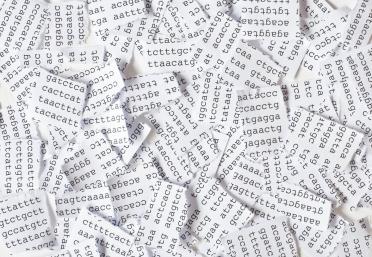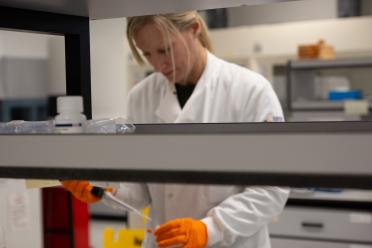Covering vast regions with one long read
A new event will explore the exciting potential of Oxford Nanopore (ONT) sequencing. The technology is widely-used at the Earlham Institute across a range of systems and species.
If you have ever accidentally shredded an irreplaceable piece of paper then you understand the frustration of spending hours painstakingly piecing together tiny strips of letters. Only to find - after hours of work - that the most important section has been taped together wrongly.
But… if the paper has simply been torn in eight pieces? Then it’s much simpler. You can see which sections are likely to follow each other. It’s quicker, easier, and there is less room for mixing up your parents while taping together your birth certificate.

This metaphor gives us an insight into why long reads are important for sequencing DNA. Long reads give researchers significant advantages, allowing the sequencing of much larger regions - including repetitive sequences - in a single read. Piecing together a genome becomes much more straightforward.
Earlham Institute researchers have been using nanopore sequencing, developed by ONT, to produce long and ultra-long reads.
Dr Conrad Nieduszynski, group leader at the Earlham Institute, has been working with the Institute’s Technical Genomics team on cutting-edge nanopore sequencing projects. In particular, ultra-long reads have been critical in his work to locate DNA replication initiation sites.
While ONT is not the only company producing technology for long reads, Conrad believes the technique has significant potential.
“Most current sequencing technologies are related to - or variations on - traditional Sanger sequencing, and rely on making new copies of DNA,” he says. “Nanopore sequencing is a completely different method.”
A strand of nucleic acids is threaded through a tiny protein pore (a nanopore) in a membrane. This causes unique disruptions in an ionic current flowing across the nanopore.
Particular bases have their own disruption signature, which allows the signal to be translated into a sequence. The read is only limited by the length of the strand being analysed.
“With other sequencing methods, the read is limited to a certain number of bases,” explains Conrad. “With nanopore sequencing, the length of the sequence is the length of the molecule. In principle, if you put in 100,000 bases, in theory that is what you’ll get out.”
Crucially, nanopore sequencing can be analysed in real time. This is hugely important where time is of the essence, such as identifying which organism is causing an acute bacterial infection or detecting levels of pathogens in the air.
The immediacy of the results allow tools, such as the Earlham Institute’s MARTi software, to go from sample to analysed sequence in a matter of hours - a key feature in our Air-Seq technology.
Nanopore technology can also detect base modifications, such as methylation, without requiring additional processing. This makes it particularly valuable for epigenomic analysis.
Direct RNA sequencing, without conversion to cDNA, is another useful feature. This is not possible with other sequencing technologies.


We have long known that quality of the input material is essential to the success of long-read sequencing experiments. This is particularly true for ultra-long read sequencing where isolating very long strands of DNA requires painstaking optimisation. It is nothing short of an art form.

Dr Karim Gharbi, Head of Technical Genomics
Dr Karim Gharbi is the Head of Technical Genomics. His team has extensive technical experience with long-read sequencing and works closely with the Earlham Institute’s faculty groups to develop new nanopore applications.
“We have long known that quality of the input material is essential to the success of long-read sequencing experiments.
“This is particularly true for ultra-long read sequencing where isolating very long strands of DNA requires painstaking optimisation. It is nothing short of an art form.”
He says the expertise of technical specialists such as those in Technical Genomics means the Institute can explore this and other novel technologies for new research applications.
“At the Earlham Institute we are fortunate to have access to the latest genomics technologies, but people with the know-how to get the most out of them are the real asset,” he adds.
He says his team has particular expertise in taking sequencing methods developed for model species and translating them to work for non-model organisms.
“Using ultra-long nanopore reads to detect large chromosomal rearrangements in wheat is a very good example of this.”

Dr Wilfried Haerty and Professor Anthony Hall are working on the wheat genome, as part of the Institute’s Delivering Sustainable Wheat (DSW) strategic programme - a collaborative initiative spearheaded by the John Innes Centre (JIC).
Wilfried’s group is using nanopore sequencing on lines from the AE Watkins collection of wheat landraces, held at JIC. The aim is to capture genomic regions previously missed because of complexity or the use of a single reference genome.
He also uses nanopore sequencing in his work on alternative splicing in human genes - the process by which multiple transcripts with different sequences are produced from a single gene.
“Long read sequencing provides us with the unique opportunity to capture a full transcript, enabling accurate characterisation and quantification of the transcripts arising from a single gene,” says Wilfried.
“Our work applying ONT sequencing demonstrated unprecedented transcript diversity identifying thousands of novel genes.
“Most importantly it showcased the need to switch from a gene-centric view to transcript-centric. Transcripts from the same genes can be expressed at different levels between tissues, cells, or time points.”
He describes long-read sequencing as fundamental, not just to DSW but also to the Institute’s strategic programmes Cellular Genomics and Decoding Biodiversity, and its Transformative Genomics National Biosciences Research Infrastructure (NBRI).

Long read sequencing provides us with the unique opportunity to capture a full transcript, enabling accurate characterisation and quantification of the transcripts arising from a single gene.

Dr Wilfried Haerty, Group Leader
The Earlham Institute is organising a Norwich Nanopore Day on September 19. Experts from across the Norwich Research Park will meet to discuss techniques and best practice.
The event is designed to bring together Norwich-based researchers who already use nanopore sequencing technologies and those interested in discovering more about the technique.
It will feature talks about current and potential applications across a wide variety of species - microbial, plant, animal, and human. It is intended to showcase and share the latest developments in nanopore sequencing across a range of protocols and systems.
“There is a lot of expertise locally but it is not always easy to access,” says Conrad.
“Some teams do work routinely and easily that other teams may not have the expertise to perform – while they in turn have another area of expertise that someone else may benefit from.
“The tendency is for groups to work separately but - in fact - if we collaborate, we can share our expertise and advance everyone’s research.”
The Earlham Institute offers training on detection of DNA base modification using nanopore sequencing. The next course runs on 4 and 5 February 2025, with registration open until 3 January.
And Nanopore Metagenomics training, showcasing our MARTi software, will be held at a date to be confirmed in July 2025.